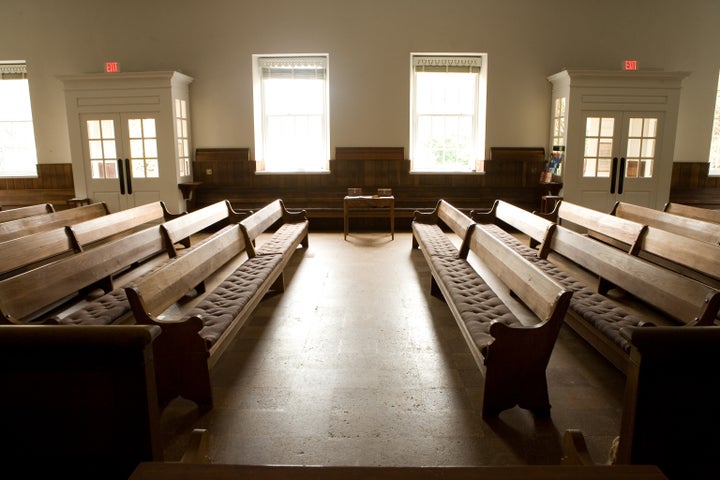
On the faded wooden benches, we sit in fidgety silence. In the school’s Quaker meetinghouse, the warmth is overwhelming on a cold winter morning, three hundred and sixty students shoulder-to-shoulder and face-to-face. It is the early nineteen-nineties and wars in Iraq, 9/11, Ferguson, San Bernardino, Freddie Gray, Orlando, Louisiana, Minnesota and Dallas are yet to be part of our consciousness. The world seems uncomplicated, though bigotry and injustice still occupy our partially developed brains.
Many Quakers believe that the “spirit of God” is in everyone. Worship is often gathered in silence, without one preacher, but rather with the understanding that each individual has equal access to that spirit within. We sit facing each other and presumably we are looking into the face of God. When someone stands to speak and we listen to the broken silence, it is the message of that spirit that connects us. Like in most Friends (Quaker) schools, less than a quarter of the students are practicing Quakers at Westtown School, our boarding and day school in suburban Philadelphia. We come from many faiths or no faith, we speak different languages and we are of diverse backgrounds and experiences, each bringing our own realities to the stillness.
In the simple meetinghouse we sit—white and black, rural and urban, domestic and foreign. Though our lives seem worlds apart, what we share is a respect for the silence, each other’s voices and the inherent value that we all bring to the community. In this quiet room, every voice matters. Fear of the “other” is only as present as we allow in the noise of our lives. We all have questions and we quietly seek the answers. We question identity, society, perplexity, unity and diversity. The answers are not definitive and often we depart with less clarity than when we entered. Our willingness to embrace the ambiguity, however, is where the power exists.
Out of the silence, my black classmate rises next to me and I am roused from my inward reflection. His message is one of frustration and hurt about race, society and equity. His volume rises and we listen, his voice quivers and we listen, his tears flow and we listen, he sits and we listen.
We do not react, but remain with his message and process his words into our own. My mind is a rush of emotion, white guilt and wonder. These meetinghouse benches have absorbed thousands of reflections. Lessons of joy, sorrow, anger, confusion, love and inspiration. This morning it is a space to confront race, ethnicity, culture and relationships. For some the message will take decades to register and for others it is more immediate. Regardless, a connection is established and that is the beauty of an education in listening and understanding.
What are today’s youth listening to? Are they like the generations before them that refused to hear or were deaf in understanding. Raised in a post-9/11 world, our children face a different reality with an African-American president, gay marriage and the interconnectedness of Facebook, Twitter, Instagram and Snapchat. Little is silent in their lives, but somehow they need to listen. What they will hear is a nation that must continue to confront issues of race, violence and difference. Hopefully with each new generation, their sophistication will grow and the fear will dissipate. To change the tide of hate, bigotry and xenophobia in this country we must encourage connection and be attentive to the messages our society provides, both overt and implicit. In an election year, there is not shortage of individuals willing to talk, incite fear and place blame. What we need is these same people to listen openly.
Welcoming silence is a skill, a muscle that requires intentional flexing. Too often we are quick to blame, to expect, to hold onto our past and to anticipate our future. It is only in the present moment that we can thoughtfully listen and seek to understand. When we sit in silence with others, we are able to look into them. When we pause before reacting we can be mindful of our own story, experience, judgment and biases. It is in these moments of silence and listening that true education occurs.
As Dr. Martin Luther King Jr., Mahatma Gandhi, Nelson Mandela, John Lennon and countless others have shown us, there is certainly a time to be vocal and to insist that others listen—a time to stand up and share a message, speak from the heart and follow one’s conscience. There are times when our pain must be voiced, times to declare that “Black Lives Matter” or that all Muslims are not terrorists. In their passionate leadership and vocal witness, however, Dr. King and others were also willing to listen and allow silence to resonant with discomfort as it did in that spacious meetinghouse twenty-five years ago. Courage can mean speaking truth to power, but it can also mean listening for the truth in the noise, regardless of origin or delivery. We must resist knee-jerk reactions in order to hear one another. This is the beauty of an education in silence.
As our hour concludes, the meetinghouse erupts with hundreds of teenage voices. The chatter and laughter spill out into the brisk air and we disperse, his message on race and hurt lingering in the empty room and in the sophistication of our awareness.
